Breastfeeding as birth control, as a contraceptive, how well does that really work?
We sort out the safety of using breastfeeding for birth control, the conditions needed for it to work, benefits and disadvantages, and other possible options in this thorough article.
 With a new baby in your arms, getting pregnant again is probably not a priority in the near future. Sex may not be very appealing either, with all the sleepless nights and tired body trying to recover from carrying the baby for 9 months and delivering him into the world. With this, the risk of getting pregnant will be at an all-time low.
With a new baby in your arms, getting pregnant again is probably not a priority in the near future. Sex may not be very appealing either, with all the sleepless nights and tired body trying to recover from carrying the baby for 9 months and delivering him into the world. With this, the risk of getting pregnant will be at an all-time low.
However, you may still want to consider birth control, since you are probably not going to aviod sexual intercourse forever. For exclusively breastfeeding mothers, the actual breastfeeding CAN be a form of contraception—if done correctly.
Breastfeeding is a well-known, albeit seemingly controversial form of birth control. This is known as the lactational amenorrhea method or LAM. While a lot of women consider it, in the end, most opt for a more traditional form of birth control. Why? It’s simple. Women have been told that breastfeeding is an unreliable form of birth control. But the truth is, breastfeeding as a form of contraception, is just as effective as most other birth control methods, provided it is done correctly.
Let’s go through how to make breastfeeding effective for birth control, its benefits and disadvantages, and other safe option. We also answer some of the most common questions about breastfeeding as birth control.
Your Guide to Breastfeeding As Birth Control
In this article…
- Why is Fertility Reduced by Breastfeeding?
- How Effective is Breastfeeding as a Birth Control Method?
- Criteria to make Breastfeeding Effective as Birth Control
- When is the Lactational Amenorrhea Method (LAM) Not Effective?
- Tips to Enhance Breastfeeding as a Natural Method of Birth Control
- The Benefits of Using Breastfeeding as Birth Control
- The Disadvantages of Breastfeeding as Birth Control
- Other Alternatives for Birth Control While Breastfeeding
- Common Questions related to Breastfeeding as Birth Control
- Takeaway
Why is Fertility Reduced by Breastfeeding?
Why does exclusive breastfeeding prevent ovulation?
The complex medical explanation of how breastfeeding works to decrease fertility is this:
“The mechanism linking the two is believed to be a neurally mediated hormonal reflex initiated by the suckling stimulus, whereby increases in the pituitary hormone prolactin act either upon the hypothalamus or directly on the ovaries to prevent ovulation.” (Alan Macfarlane – 2002)
In other words, the suckling that takes place during breastfeeding stimulates an automatic trigger that produces a hormonal reaction, so that the level of prolactin increases. Interestingly, studies have shown that increased levels of prolactin inhibit ovarian activity (no ovulation). The more times and the longer the baby suckles on the nipple, the higher the prolactin levels increase.
The contraceptive effect (or the decrease in fertility) while breastfeeding is directly linked to an increase in prolactin.
Interestingly, studies have shown that levels of prolactin increase as the level of nutrition decreases in the mother as well, so this could be due to an automatic contraception “device” that the female body has innately and is used in times of hardship. (No food = not a good time to have a baby)
How Effective is Breastfeeding as a Birth Control Method?
It should be known to new moms that LAM is a short-term type of contraception. It depends on the woman’s menstrual return since childbirth, how she breastfeeds her baby (feed on demand, no supplementary food given, and how long the baby suckles on her nipple), and on the baby’s age (less than 6 months), as shown below:
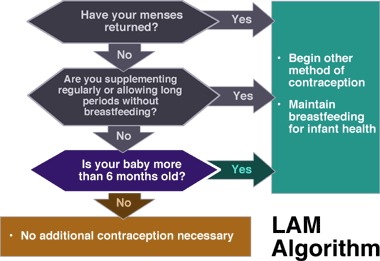
When all these criteria are met, meaning the woman has been amenorrheic since her baby was born, has been exclusively breastfeeding her baby, feeding on-demand around the clock, and with a less than 6-month-old baby, there is a very low chance of pregnancy. If breastfeeding is done correctly, it is 98% effective in preventing pregnancy; 99% according to some studies. This can be compared with condoms (85% prevention) and birth control pills (92-99.7% depending on the type).
Here’s a comparison of some of the known and commonly used contraceptives as to the chances of getting pregnant (with the right manner of use):
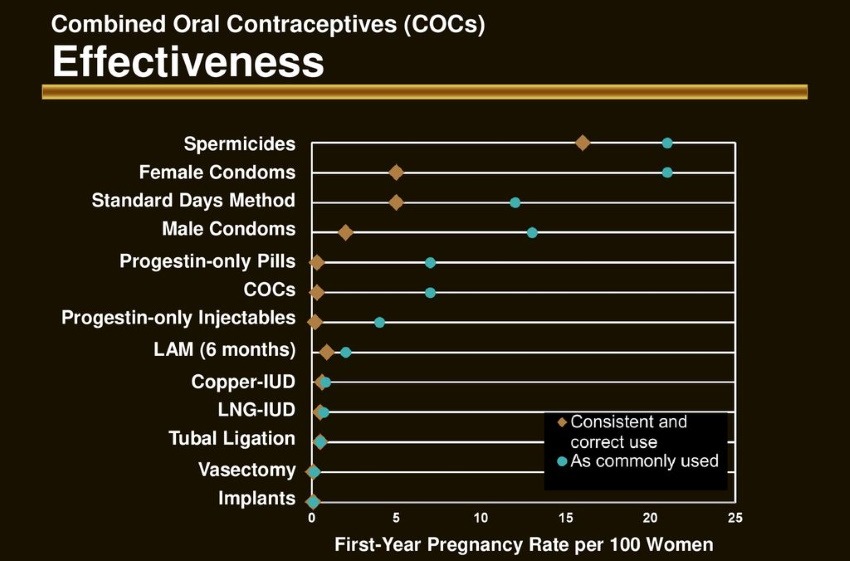
For LAM users, when the method is consistently and correctly done (used), the chances for pregnancy are very low as opposed to other temporary contraceptives.
In comparison to other forms of birth control, the lactational amenorrhea method is effective in preventing pregnancy. The only forms of birth control that have slightly better results are some birth control pills and IUDs. Methods such as tubal ligation and vasectomy are, of course, safer, but not temporary.
Criteria to make Breastfeeding Effective as Birth Control
So what does doing LAM correctly entail?
- First, you have to be doing breastfeeding exclusively; you cannot use supplementary feeding (formula).
- Second, you feed your baby on demand, day and night, without any interruptions. Suckling is consistent and done for long periods.
- Third, as mentioned before, your baby has to be younger than six months old. By the 6th month, they are introduced to another form of supplementary feeding that is solids.
- And lastly, you have had no menses since your baby was born. (for the purposes of LAM this is defined as any bleeding, on any two consecutive days, that occurs 2 months after the birth)
When is the Lactational Amenorrhea Method (LAM) Not Effective?
- When your menses returned. Spotting or bleeding after the first 2 to 3 months is a sign that fertility may return soon, and that ovulation may be a possibility soon or has already returned.
- When the baby starts on supplementary feeding. When you are not exclusively breastfeeding anymore, the chances of fertility returning is high. Supplementary feeding will decrease the demand to suckle, hence ovulatory activity may increase. Remember the mechanism by which the suckling reflex prevents ovulation and fertility, hence you should look for other contraceptives when this happens.
- When your baby is older than 6 months. by the 6th month, your baby will usually be introduced to supplementary feeding, thereby decreasing the demand to feed on your breasts. If you introduce solids earlier, the effectiveness of LAM will, of course, be reduced at that time.
A woman should be thoroughly advised on the possibilities of pregnancy when this happens. And to be offered other birth control methods that may be more effective for her and her partner.
Tips to Enhance Breastfeeding as a Natural Method of Birth Control
It is important to understand that the return of fertility will vary from woman to woman. Your physiology coupled with the nursing patterns of your baby will determine when your fertility will return to “normal.” There are a few things that you can do to help you get the most out of breastfeeding as a reliable and natural form of birth control.
The total amount of time that is spent breastfeeding in 24 hours along with the frequency at which you are breastfeeding are the two strongest factors that determine the return of fertility. Should your baby start nursing less often or for a decreased amount of time, the effectiveness of LAM is reduced. To help maintain both of these circumstances, consider doing what is called ecological breastfeeding.
The seven standards of ecological breastfeeding are the following:
- Breastfeed exclusively for 6 months.
- Breastfeed on demand all day and night
- Use breastfeeding as a way to comfort the baby when he is upset
- Use lying down position for breastfeeding during nap time
- Stay close to your baby and avoid any schedules that will separate you.
- Co-sleep for nighttime feedings
- Avoid pacifiers and bottles
Ecological breastfeeding is stricter than LAM, which doesn’t mention lying down for breastfeeding or co-sleeping as requirements. But it is effective! The average return of menstruation for ecologically breastfeeding mothers is between 14 and 15 months postpartum.
A sidenote on co-sleeping…
Co-sleeping is common (I did it too) and you can read about safety measure for co-sleeping here. However, you should be aware that the American Academy of Pediatrics recommends room sharing, but not bedsharing for babies to minimize the risk of Suden Infant Death Syndrome.
The risk of SIDS is real and if you do want to co-sleep, you really need to read up on how to do it in the safest possible way.
The Benefits of Using Breastfeeding as Birth Control
There are a lot of benefits from LAM:
- It is free and safe.
- Once you begin nursing or breastfeeding, the mechanism of LAM starts.
- There is no need for a prescription or a series of consultations with a doctor.
- It doesn’t interrupt sexual intercourse.
- It reduces bleeding postpartum.
As much as it benefits the mother, it is also equally beneficial for the new baby:
- Breastmilk provides all the antibodies and nutrients that a baby needs for the first 6 months of his life. It gives the best nutrients there is.
- It is free and a very cost-effective way of feeding your baby.
- Breastfeeding enhances the mother and child bonding and strengthens that bond as the frequency of breastfeeding increases.
- Breastmilk decreases the chances of allergies and asthma.
The Disadvantages of Breastfeeding as Birth Control
However appealing this method is, it is still the hardest to stick to. Here is a list of disadvantages of LAM as birth control:
- Exclusively breastfeeding your baby each time he demands to be fed, is physically tiring for a woman who has just given birth. She would have to get up every single time he is hungry. You will not only be sleepless but end up physically and emotionally drained for doing all this for 6 months straight.
- The success of this method will depend on your commitment to breastfeeding exclusively and the suckling reflex of your baby. If the baby suckles for a short while, this method as birth control is less likely to succeed. There have been studies showing that babies that suckle for only a short while and less frequently have mothers get fertile faster and earlier.
- This is a short-term birth control method. There are no guarantees that LAM can go on for extended periods because fertility will return sooner or later.
- Sexual libido will be decreased when a woman is exclusively breastfeeding.
Other Alternatives for Birth Control While Breastfeeding
You can use other contraceptives while breastfeeding. They have been proven safe for you and your baby. Here are some of the contraceptives that you can use while breastfeeding:
- Birth control pills (progesterone only)– these hormone replacement pills are safe and effective—if used properly. They have been proven to be 98% effective protection against pregnancy. These, however, are not protective against sexually transmitted diseases (STDs).
- Implants – These are inserted into your arm. A little invasive but very effective. This implant releases hormones into your body which prevents you from becoming fertile. They are 99% effective in preventing pregnancy. You can have your implant replaced after 3 years. Like birth control pills, these are not protective against STDs.
- Intrauterine device – this is a e.g. copper rod that is inserted into your uterus. This releases hormones that will prevent fertility. It also prevents sperm from reaching your egg cells. This is almost 100% effective and is long-lasting. This can last you up to 10 to 12 years. However, this is also not protective against STDs.
- Condoms – these are adequately protective against both pregnancy and STDs, when used properly and correctly. However, this is not safe for those with Latex allergies.
Pills containing estrogen are not safe for breastfeeding as it decreases the milk supply in your body. The same goes for the patch or the ring (estrogen-containing products).
Common Questions related to Breastfeeding as Birth Control
Do I need to stop breastfeeding to get pregnant?
You can still breastfeed if you want to be pregnant, but the consistency and frequency should be decreased for your fertility to go back to normal. Always remember the mechanism of LAM: exclusive breastfeeding and feeding on demand (and the suckling reflex of your baby), no menses for the past 6 months, and no supplemental feeding. A break in any of the criteria for a successful LAM will lead to fertility and later on pregnancy.
What are the signs of ovulation if I am breastfeeding?
A change in the libido (increase in the sexual drive), a change in the vaginal discharges, or cervical mucus are usual signs of ovulation. You can still ovulate while breastfeeding, so these are not out-of-the-ordinary occurrences. Find additional signs of ovulation here.
I am pumping – can I use breastfeeding as birth control?
For LAM to be effective as a birth control method, the baby has to suckle frequently and consistently on the mother’s nipples. Pumping will be a less efficient and effective way of expressing milk. And will be a little different from the actual suckling reflex of your baby. This will make LAM less effective, so the answer is no.
Takeaway
The bottom line is that breastfeeding is an excellent form of birth control when done correctly. During the first three months, the chance of pregnancy is almost zero, less than two percent from three to six months; after six months, the risk goes to 6%.
A mother’s commitment to doing this correctly will determine the success of this natural birth control method.
Research References
What is the lactational amenorrhea method of contraception?
Lactational Amenorrhea Method (CDC)
Lactational amenorrhea for family planning
Have you considered or tried breastfeeding to protect from pregnancy? Please share your thoughts by leaving a comment below.

Paula Dennholt founded Easy Baby Life in 2006 and has been a passionate parenting and pregnancy writer since then. Her parenting approach and writing are based on studies in cognitive-behavioral models and therapy for children and her experience as a mother and stepmother. Life as a parent has convinced her of how crucial it is to put relationships before rules. She strongly believes in positive parenting and a science-based approach.
Paula cooperates with a team of pediatricians who assist in reviewing and writing articles.

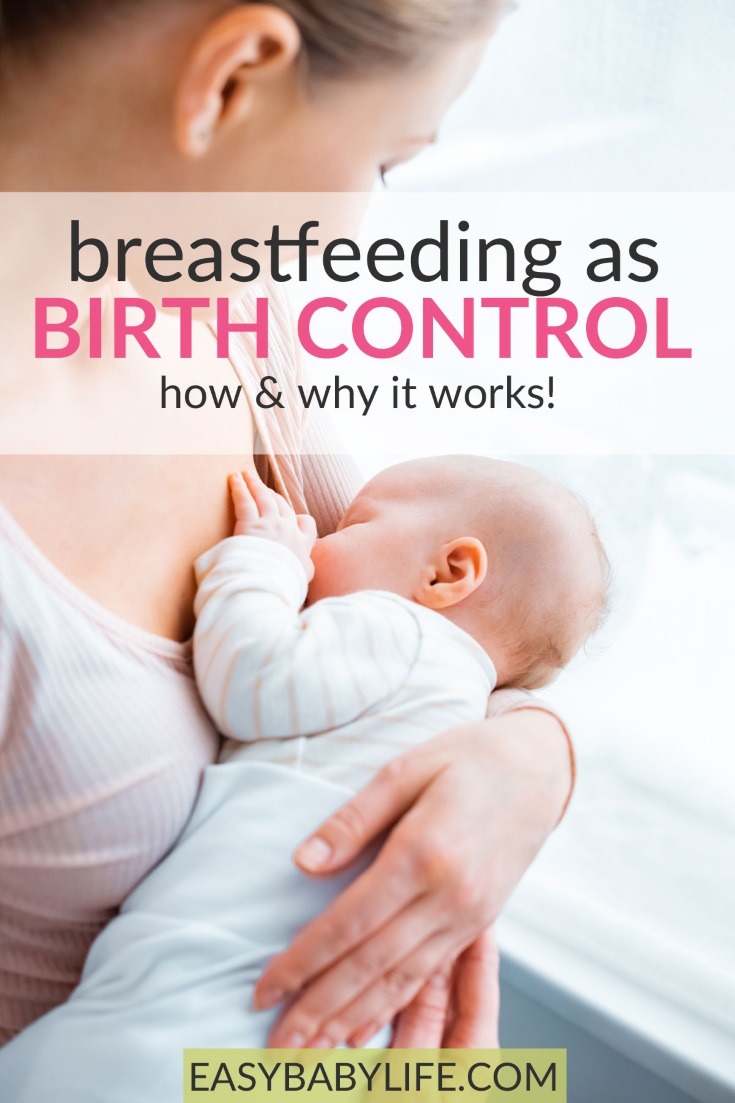

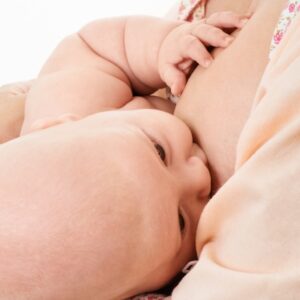



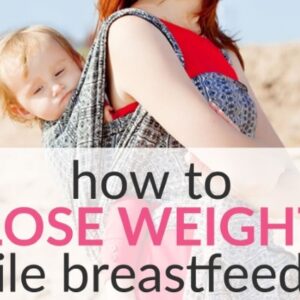
I am first time mum, doing exclusive for my by baby girl by pumping and and she suck on demand especially at night, I delivered on Feb and my period started the march , now she is 6 months and I wish to take in again but no way though am still breast feeding her while trying to introduce her to formula and solid food but she doesn’t seem to be ready for that. I need to start trying for baby no 2 .I wish to stop breast feeding but people said is too early to stop.
Hi Henrietta,
If your period is already back, then there is no need to stop breastfeeding to try to conceive. It is generally recommended to breastfeed for 12 months, but start introducing solid foods at around 6 months. This way, your daughter will be weaned off the breast slowly. That said, only you can decide when it is time to stop breastfeeding, since it is your body. But you don’t need to do it to try for another baby.
Best wishes,
Paula